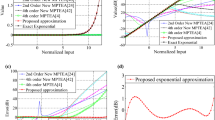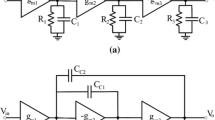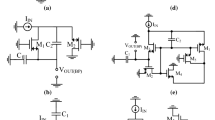Abstract
A multi-stage amplifier is a frequency compensated via a single and small MOSFET based capacitor. The idea reduces die occupation considerably since removes any passive elements in the compensation network. Also, a normal differential pair and a MOSFET based capacitor form compensation network and boost DC gain simultaneously. The proposed approach is symbolically described via MATLAB and numerically simulated via HSPICE circuit simulator using standard TSMC 0.18µ CMOS technology. According to mathematical justifications and simulation results, the proposed amplifier shows operation excellency especially in terms of die occupation and frequency response parameters which make it appropriate choice to realize larger analog and mixed mode systems like modulators and data converters.




















Similar content being viewed by others
References
Akbari, M., et al. (2014). Design and analysis of DC gain and transconductance boosted recycling folded cascode OTA. AEU-International Journal of Electronics and Communications,68(11), 1047–1052.
Akbari, M., et al. (2015). High performance folded cascode OTA using positive feedback and recycling structure. Analog Integrated Circuits and Signal Processing,82(1), 217–227.
Aghaee, T., Biabanifard, S., & Golmakani, A. (2017). Gain boosting of recycling folded cascode OTA using positive feedback and introducing new input path. Analog Integrated Circuits and Signal Processing,90(1), 237–246.
Grasso, A. D., Palumbo, G., & Pennisi, S. (2008). Analytical comparison of frequency compensation techniques in three-stage amplifiers. International Journal of Circuit Theory and Applications,36(1), 53–80.
Shahsavari, S., et al. (2015). DCCII based frequency compensation method for three stage amplifiers. AEU-International Journal of Electronics and Communications,69(1), 176–181.
Grasso, A. D., Marano, D., Palumbo, G., & Pennisi, S. (2010). Analytical comparison of reversed nested Miller frequency compensation techniques. International Journal of Circuit Theory and Applications,38(7), 709–737.
Largani, S. M. H., et al. (2015). A new frequency compensation technique for three stages OTA by differential feedback path. International Journal of Numerical Modelling: Electronic Networks, Devices and Fields,28(4), 381–388.
Peng, X., & Sansen, W. (2004). AC boosting compensation scheme for low-power multistage amplifiers. IEEE Journal of Solid-State Circuits,39(11), 2074–2079.
Lee, H., & Mok, P. K. T. (2003). Active-feedback frequency-compensation technique for low-power multistage amplifiers. IEEE Journal of Solid-State Circuits,38(3), 511–520.
Biabanifard, S., et al. (2015). High performance reversed nested Miller frequency compensation. Analog Integrated Circuits and Signal Processing,85(1), 223–233.
Grasso, A. D., Palumbo, G., & Pennisi, S. (2007). Advances in reversed nested Miller compensation. IEEE Transactions on Circuits and Systems I: Regular Papers,54(7), 1459–1470.
Akbari, M., Biabanifard, S., & Hashemipour, O. (2014). Design of ultra-low-power CMOS amplifiers based on flicker noise reduction. In 2014 22nd Iranian conference on electrical engineering (ICEE). IEEE.
Aloisi, W., Palumbo, G., & Pennisi, S. (2008). Design methodology of Miller frequency compensation with current buffer/amplifier. IET Circuits, Devices and Systems,2(2), 227–233.
Shahsavari, S., et al. (2014) A new frequency compensation method based on differential current conveyor. In 2014 22nd Iranian conference on electrical engineering (ICEE). IEEE.
Leung, A. K. N., et al. (1999). Damping‐factor‐control frequency compensation technique for low‐voltage low‐power large capacitive load applications. In 1999 IEEE international solid‐state circuits conference, 1999. Digest of technical papers. ISSCC. IEEE.
Largani, S. M. H., et al. (2014). A new SMC compensation strategy for three stage amplifiers based on differential feedback path. In 2014 22nd Iranian conference on electrical engineering (ICEE). IEEE.
Akbari, M., Biabanifard, S., & Asadi, S. (2015). Input referred noise reduction technique for trans-conductance amplifiers. Electrical and Computer Engineering: An International Journal (ECIJ),4(4), 11–22.
Biabanifard, S., et al. (2018). Three stages CMOS operational amplifier frequency compensation using single Miller capacitor and differential feedback path. Analog Integrated Circuits and Signal Processing,97(2), 195–205.
Biabanifard, S., et al. (2018). Multi stage OTA design: From matrix description to circuit realization. Microelectronics Journal,77, 49–65.
Chaharmahali, I., Asadi, S., & Dousti, M. (2016). Design procedure for three-stage CMOS OTAs with AC boosting frequency compensation technique. IETE Journal of Research,62(5), 705–713.
Chaharmahali, I., et al. (2017). A new method modifying single Miller feedforward frequency compensation to drive large capacitive loads: Putting an attenuator in the path. Analog Integrated Circuits and Signal Processing,93(1), 61–70.
Zaherfekr, M., & Biabanifard, A. (2019). Improved reversed nested miller frequency compensation technique based on current comparator for three-stage amplifiers. Analog Integrated Circuits and Signal Processing,98(3), 633–642.
Khalesi, H., & Ghods, V. (2019). QPSK modulation scheme based on orthogonal Gaussian pulses for IR-UWB communication systems. Journal of Circuits, Systems and Computers,28(1), 1950008 (1–13).
Author information
Authors and Affiliations
Corresponding author
Additional information
Publisher's Note
Springer Nature remains neutral with regard to jurisdictional claims in published maps and institutional affiliations.
Rights and permissions
About this article
Cite this article
Babazadeh Daryan, B., Khalesi, H., Ghods, V. et al. Multi-stage CMOS amplifier frequency compensation using a single MOSCAP. Analog Integr Circ Sig Process 103, 237–246 (2020). https://doi.org/10.1007/s10470-020-01595-z
Received:
Revised:
Accepted:
Published:
Issue Date:
DOI: https://doi.org/10.1007/s10470-020-01595-z




